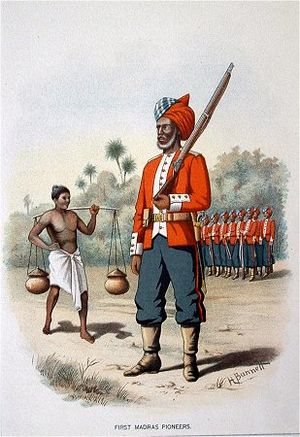The 1st Madras Pioneers, c. 1890
The Queen’s Own Madras Sappers and Miners, Review Order 1896.
The Madras Army, established by the East India Company, was one of the three presidency armies in India. The other two armies were the Bengal Army and the Bombay Army, and all three were abolished in 1895 and replaced by a single Indian Army.
There were European companies in the Madras Army from an early period, and it is known that there were three in 1742 and seven in 1748, when they were formed into a single regiment. In 1824, the Madras Army consisted of two European infantry battalions , fifty-two Madras Native Infantry battalions, three irregular infantry battalions, three light cavalry regiments, one European and one native artillery brigade, three battalions (of four companies each) of foot artillery, and two pioneer corps.
The Madras Army soldiers showed exceptional discipline and loyalty throughout the Indian Mutiny, and unlike the other two presidency armies, no Madras Army units mutinied. This fidelity can probably be attributed to the recruiting methods the Madras and Bombay Armies shared. While the soldiers of these two armies were generally of a lower caste (and physically shorter) , they were more concerned with gaining respect through their own merit and efforts, and much less interested in caste and class practices and traditions. This attitude also made Madras and Bombay Army soldiers more disciplined.
The post-mutiny army reorganization had little impact on the Madras Army, other than the renumbering of units.
The strength of the Madras Army in 1876 totaled 47,144 officers and men, broken down into 33,968 Indian Army officers and other ranks and 13,176 British Army officers and men. The Madras Army was the second largest of the three presidency armies.
References: Beaumont (1977); Haythornthwaite (1995); Heathcote (1974); Hervey (1988); Mason (1974); Mason (1985);Wolseley (1878); Yong (2002)
